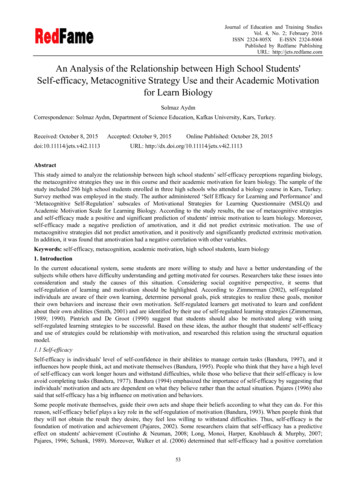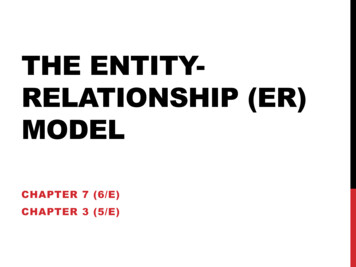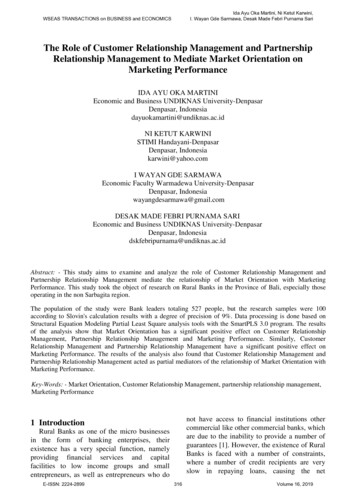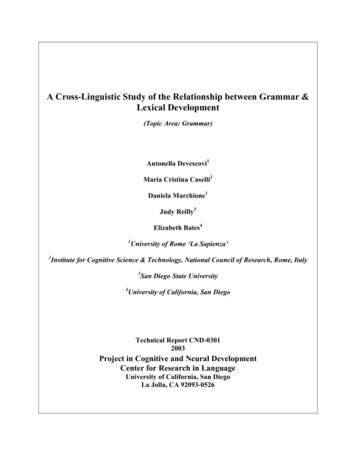
Transcription
Journal of Education and Training StudiesVol. 4, No. 2; February 2016ISSN 2324-805X E-ISSN 2324-8068Published by Redfame PublishingURL: http://jets.redfame.comAn Analysis of the Relationship between High School Students'Self-efficacy, Metacognitive Strategy Use and their Academic Motivationfor Learn BiologySolmaz AydınCorrespondence: Solmaz Aydın, Department of Science Education, Kafkas University, Kars, Turkey.Received: October 8, 2015doi:10.11114/jets.v4i2.1113Accepted: October 9, 2015Online Published: October 28, 2015URL: his study aimed to analyze the relationship between high school students’ self-efficacy perceptions regarding biology,the metacognitive strategies they use in this course and their academic motivation for learn biology. The sample of thestudy included 286 high school students enrolled in three high schools who attended a biology course in Kars, Turkey.Survey method was employed in the study. The author administered ‘Self Efficacy for Learning and Performance’ and‘Metacognitive Self-Regulation’ subscales of Motivational Strategies for Learning Questionnaire (MSLQ) andAcademic Motivation Scale for Learning Biology. According to the study results, the use of metacognitive strategiesand self-efficacy made a positive and significant prediction of students' intrisic motivation to learn biology. Moreover,self-efficacy made a negative prediction of amotivation, and it did not predict extrinsic motivation. The use ofmetacognitive strategies did not predict amotivation, and it positively and significantly predicted extrinsic motivation.In addition, it was found that amotivation had a negative correlation with other variables.Keywords: self-efficacy, metacognition, academic motivation, high school students, learn biology1. IntroductionIn the current educational system, some students are more willing to study and have a better understanding of thesubjects while others have difficulty understanding and getting motivated for courses. Researchers take these issues intoconsideration and study the causes of this situation. Considering social cognitive perspective, it seems thatself-regulation of learning and motivation should be highlighted. According to Zimmerman (2002), self-regulatedindividuals are aware of their own learning, determine personal goals, pick strategies to realize these goals, monitortheir own behaviors and increase their own motivation. Self-regulated learners get motivated to learn and confidentabout their own abilities (Smith, 2001) and are identified by their use of self-regulated learning strategies (Zimmerman,1989; 1990). Pintrich and De Groot (1990) suggest that students should also be motivated along with usingself-regulated learning strategies to be successful. Based on these ideas, the author thought that students' self-efficacyand use of strategies could be relationship with motivation, and researched this relation using the structural equationmodel.1.1 Self-efficacySelf-efficacy is individuals' level of self-confidence in their abilities to manage certain tasks (Bandura, 1997), and itinfluences how people think, act and motivate themselves (Bandura, 1995). People who think that they have a high levelof self-efficacy can work longer hours and withstand difficulties, while those who believe that their self-efficacy is lowavoid completing tasks (Bandura, 1977). Bandura (1994) emphasized the importance of self-efficacy by suggesting thatindividuals' motivation and acts are dependent on what they believe rather than the actual situation. Pajares (1996) alsosaid that self-efficacy has a big influence on motivation and behaviors.Some people motivate themselves, guide their own acts and shape their beliefs according to what they can do. For thisreason, self-efficacy belief plays a key role in the self-regulation of motivation (Bandura, 1993). When people think thatthey will not obtain the result they desire, they feel less willing to withstand difficulties. Thus, self-efficacy is thefoundation of motivation and achievement (Pajares, 2002). Some researchers claim that self-efficacy has a predictiveeffect on students' achievement (Coutinho & Neuman, 2008; Long, Monoi, Harper, Knoblauch & Murphy, 2007;Pajares, 1996; Schunk, 1989). Moreover, Walker et al. (2006) determined that self-efficacy had a positive correlation53
Journal of Education and Training StudiesVol. 4, No. 2; February 2016with intrisic motivation, a negative correlation with amotivation and had no correlation with extrinsic motivation. Basedon this information in the relevant literature, the author concluded that self-efficacy had a direct relationship withstudent motivation.1.2 The Use of Metacognitive StrategyMetacognition is a person's being informed and conscious about his or her own cognition (Flavell, 1979; Zimmerman,2002). According to Flavell (1979), past studies have concluded that metacognition plays an important role incommunication, reading comprehension, concentration, memory and problem solving. In these aspects, the knowledgeof metacognition is important in education. Metacognition is classified into two types: ‘knowledge of cognition’ and‘regulation of cognition’. Knowledge of cognition is the things that people know about their own cognition. Regulationof cognition includes the metacognitive activities that help regulate cognition (Schraw & Moshman, 1995).Paris and Winograd (1990) said that teachers can increase students' metacognitive awareness by means of effectiveproblem solving strategies and scientific discussions, and this will provide two benefits: 1) the teacher conveys theresponsibility to students to watch their learning, and 2) students develop positive self-perception and motivation.Landine and Stewart (1998) suggested that there was a positive correlation between intrinsic motivation, academicachievement and the use of metacognitive strategies. Similarly, Biggs (1985) said that intrinsic motivation is animportant factor of metacognition and academic achievement. Biggs (1988) also said that metacognition had a majoreffect on increasing learning. Accordingly, Tas, Brown, Esen-Danaci, Lysaker and Brüne (2012) argued thatmetacognition is correlated with intrinsic motivation.1.3 Academic MotivationMotivation is to get into action to do something (Ryan & Deci, 2000a). Deci and Ryan (1985) made a basicclassification of motivation and suggested three categories: intrinsic motivation, extrinsic motivation and amotivation.Intrinsic motivation means that a person does something due to a wish from inside. Extrinsic motivation means that aperson does something for the sake of its result. Amotivation means being unwilling to do something (Deci & Ryan,2000).Gottfried (1985, 1990), found that academic intrinsic motivation in elementary and junior high school students had apositive correlation with student achievement and self-efficacy perception. Goldberg and Cornell (1998) conducted astudy with a structural equation model and found that intrinsic motivation affected perceived competence, whichaccordingly affected academic achievement. The relevant literature also says that academic motivation has a positiveinfluence on students’ performance and achievement (Fortier, Vallerand & Guay, 1995; Noels, Clement & Pelletier,2001; Wentzel & Wigfield, 1998).A review of the studies summarized above shows that the research is mainly focused on intrinsic motivation. Moreover,it was found that the studies which analyzed the influence of self-efficacy and metacognitive strategies on academicmotivation were insufficient in general. It was observed that researchers mainly accepted motivational processes such asself-efficacy and goal orientation as academic motivation in the relevant literature. Since this study tackled thedimensions of academic motivation based on self-determination theory (intrinsic motivation, extrinsic motivation andamotiation), the author believes that the study will contribute to the literature. In addition, the relevant literature did notinclude any studies which were specifically based on academic motivation for learning biology since the studies weremainly about students' general academic motivation. This study will also contribute to the field of science education inthis respect.This study aimed to analyze the relationship between high school students' self-efficacy perceptions, the metacognitivestrategy use and their academic motivation to learn biology. The structural model created for this purpose is shown inFigure 1.IntrinsicSelf-EfficacyAmotivationExtrinsic Motivation-CareerMetacognitive StrategyExtrinsic-Motivation-SocialFigure 1. The structural model of the relationship between self-efficacy, use of metacognitive strategies and academicmotivation54
Journal of Education and Training StudiesVol. 4, No. 2; February 20162. Method2.1 Study SampleThe sample of the study included 286 high school students. The author randomly selected three schools of the fiveAnatolian high schools in Kars, Turkey, and included 136 female and 150 male students in the sample. Anatolian highschools provide a four-year education which prepares students for higher education according to their interests, talentsand achievement. At these schools, students can select specific courses according to the field they want to study atuniversity. The author selected the participants of this study from classes that attend the biology course. The students'ages ranged between 15 and 17, and their GPA in biology was 3.13 on a scale of 5.2.2 Data Collection ToolsSelf-efficacy for Learning and Performance ScaleTo determine high school students' levels of self-efficacy for learning biology, the author used the Self-efficacy forLearning and Performance sub-scale of the Motivational Strategies for Learning Questionnaire (MSLQ). Sungur (2004)translated the scale into Turkish and did the validity and reliability analyses. It is a 7-point Likert-type scale thatincludes eight items. Table 1 shows sample items, descriptive statistics and reliability value (alpha).Metacognitive Self-regulation ScaleThe author used the Metacognitive Self-Regulation, a sub-scale of the Motivational Strategies for LearningQuestionnaire (MSLQ) scale to measure high school students' levels of using metacognitive strategies when learningbiology. Sungur (2004) translated the scale into Turkish and did the validity and reliability analyses. It is a 7-pointLikert type scale that includes 12 items. Table 1 demonstrates the sample items, descriptive statistics and reliabilityvalue (alpha).Academic Motivation Scale for Learning BiologyThe author used the Academic Motivation Scale for Learning Biology to measure students' motivation to learn biology.The scale was created by Aydın, Yerdelen, Gürbüzoğlu, Yalmancı and Göksu (2014), who also did the validity andreliability analyses. It is a 6-point Likert type scale which includes 19 items and four sub-dimensions. Thesesub-dimensions are intrinsic motivation (IM-6 items), amotivation (A-5 items), extrinsic motivation–career (EM-C-4items) and extrinsic motivation–social (EM-S-4 items). Table 1 shows sample items, descriptive statistics and reliabilityvalue (alpha).Table 1. Sample scale items and descriptive statisticsVariablesSelf-efficacy (SE)I believe I will receive an excellent grade in biology classMetacognitive self-regulation (MC)When studying for biology I try to determine which concepts I don't understandwellIntrinsic motivation (IM)I enjoy learning biology subjectsAmotivation (A)Honestly, I don't know why I should learn biologyExtrinsic motivation-career (EMC)Because it is important in my choice of professionExtrinsic motivation-social (EMS)I want to be praised by the people around .641.39.8363.811.40.8253.571.30.7272.3 ProcedureSurvey method was employed in the study. The author administered ‘Self Efficacy for Learning and Performance’ and‘Metacognitive Self-Regulation’ subscales of Motivational Strategies for Learning Questionnaire (MSLQ) andAcademic Motivation Scale for Learning Biology. The data were collected from the participants in their ownclassrooms, and those who voluntarily agreed to participate in the study after being informed about its purpose wereincluded in the sample. Additionally, the students were informed that they could withdraw from the study wheneverthey wanted.3. Results3.1 CorrelationsTable 2 shows the Pearson correlation coefficients generated by the correlation analysis conducted on the variables inthe study.55
Journal of Education and Training StudiesVol. 4, No. 2; February 2016Table 2. Pearson correlation coefficientsVariablesSelf efficacy (SE)Metacognitive self-regulation (MC)İntrinsic motivation (IM)Amotivation (A)Extrinsic motivation-career (EMC)Extrinsic motivation-social 277**-.078.366**1Table 2 shows that self-efficacy and the use of metacognitive strategies were correlated with academic motivation,which was also implied by the structural model created for this study. The highest correlations were betweenself-efficacy and the use of metacognitive strategies (r .588, p .01), and between self-efficacy and intrinsic motivation(r .480, p .01). Moreover, there were positive correlations between intrinsic motivation and extrinsic motivation-career(r .475, p .01), between the use of metacognitive strategies and extrinsic motivation-career (r .413, p .01), andbetween the use of metacognitive strategies and intrinsic motivation (r .402, p .01). In general, intrinsic motivation hada negative correlation with amotivation, and a positive correlation with other variables, which was the expectedoutcome.In addition, it was found that amotivation had a negative correlation with self-efficacy, the use of metacognitivestrategies, intrinsic motivation and extrinsic motivation-career.Path AnalysisThe path model (Figure 1) created with the purpose of determining the relationship between high school students'self-efficacy, levels of using metacognitive strategies in biology and motivation to learn biology was tested usingLISREL 8.80 (Jöreskog and Sörbom, 2006). The results of the analysis showed that the fit indices had good consistencywith the model's data set (χ2(693) 1400.28, p .05; χ2/SD 2.02; RMSEA 0.060; CFI .95, NFI .91; NNFI .95;SRMR .078). Figure 2 shows the size and direction of the relationship between the variables in the path model.Figure 2. The model with standardized path coefficientsAn analysis of the standardized path coefficients in this model showed that intrinsic motivation had positive relationshipwith self-efficacy (β .30) and the use of metacognitive strategies (β .33). The variables of self-efficacy and the use ofmetacognitive strategies explained 34% of the variance of intrinsic motivation. Amotivation variable was related only toself-efficacy (β -.28) and it was a negative relation. Self-efficacy explains 20% of the variance of amotivation. Theextrinsic motivation-career (β -.54) and extrinsic motivation-social (β .50) variables related only to the use ofmetacognitive strategies. The use of metacognitive strategies explained 31% of extrinsic motivation-career variance and18% of extrinsic motivation-social variance.4. DiscussionThis study aimed to determine the variables that affect high school students' motivation to learn biology. Moreover, theauthor tried to find the dimension of motivation by focusing on the sub-dimensions of motivation. Initially, the studyanalyzed the correlations between the variables. The results showed that self-efficacy had a strong correlation with theuse of metacognitive strategies and intrinsic motivation. An analysis of the relevant studies indicated that they alsofound positive correlations between them (Coutinho, 2008; Coutinho & Neuman, 2008; Kanfer & Ackerman, 1989;Yerdelen, 2013; Walker et al., 2006). Coutinho (2008) found that there was a strong correlation between self-efficacyand metacognitive awareness, and that these variables affected student performance. This means that the students whohave a high self-efficacy and metacognitive awareness have better performance. Additionally, Kanfer and Ackerman(1989) claim that it is more likely that people with strong self-efficacy will use metacognitive strategies.56
Journal of Education and Training StudiesVol. 4, No. 2; February 2016Another noteworthy result of the study was that amotivation had a negative correlation with self-efficacy, the use ofmetacognitive strategies, intrinsic motivation and extrinsic motivation-career. This is due to the fact that students whoare unenthusiastic about and uninterested in biology have low self-efficacy and internal motivation, cannot use theirmetacognitive strategies at a sufficient level and do not think that learning biology will contribute to their selection of afuture profession. Walker et al. (2006) and Turner, Chandler and Heffer (2009) suggested that amotivation andself-efficacy had a negative correlation. Vallerand et al. (1993) also says that amotivation has negative correlations withother variables of motivation.This study conducted a path analysis on the relationship between self-efficacy, the use of metacognitive strategies andacademic motivation. The results of this analysis indicated that self-efficacy and the use of metacognitive strategiespredicted students' intrinsic motivation in a positive and significant way. A review of the relevant studies showed thatthe results were consistent with the relevant literature (Walker et al., 2006; McAuley, Wraith, Duncan, 1991; Lau &Chan, 2003; Tas, Brown, Esen-Danaci, Lysaker & Brüne, 2012; Vandergrift, 2005; Landine & Stewart, 1998). Inaddition, Lau and Chan (2003) suggested that intrinsic motivation had a stronger relationship with student ability andstrategy use compared to the other variables of motivation. Ryan and Deci (2000b) said that efficacy belief couldincrease intrinsic motivation.Another result of the study was that self-efficacy made a negative prediction of amotivation while the use ofmetacognitive strategies did not predict it. People who do not perceive a consistency between their acts and the resultslose their motivation. They have neither intrinsic nor extrinsic motivation, regard themselves as insufficient and theirparticipation in academic activities may cease (Vallerand et al., 1992). For this reason, it was an expected outcome thatpoorly motivated students had low self-efficacy, did not use metacognitive strategies and were not enthusiastic about thebiology course. Baker (2004) determined that amotivation caused a high level of stress perception and poorpsychosocial adjustment. Moreover, Vallerand and Bissonnette (1992) found that amotivation had a negative effect onthe maintenance of a specific behavior. They also said that amotivation seemed to be a strong indicator of negativeoutcomes, which means that future studies should focus on amotivation.Another result of the study implied that self-efficacy did not predict extrinsic motivation, while the use of metacognitivestrategies predicted extrinsic motivation. In contrast with intrinsic motivation which is related to the natural satisfactionof an act, extrinsic motivation is related to performance for the sake of acquiring a result (Ryan & Deci, 2000b). For thisreason, it is estimated that the use of metacognitive strategies predicts extrinsic motivation, which is in contrast withself-efficacy. A review of the relevant literature showed that there are also studies which did not find any relationshipbetween self-efficacy and extrinsic motivation (Walker et al., 2006). Similarly, Baleghizadeh and Rahimi (2011) foundthat the use of metacognitive strategies had a positive correlation with intrinsic and extrinsic motivation, while it did nothave any correlation with amotivation, which is consistent with the results of this study. This means that the studentswho use metacognitive strategies have intrinsic and extrinsic motivation. Extrinsic motivation causes students to choosegoals that they cannot reach. On the other hand, the students who have intrinsic motivation have fewer unreachablegoals since they believe that they can achieve if they try (Shannon, 2008). This shows the effect of self-efficacy onintrinsic motivation.ReferencesAydın, S., Yerdelen, S., Gürbüzoğlu, Y. S., & Göksu, V. (2014). Academic motivation scale for learning biology: a scaledevelopment study. Education and Science, 39(176), 425-435. http://dx.doi.org/10.15390/eb.2014.3678Baker, S. R. (2004). Intrinsic, extrinsic, and amotivational orientations: Their role in university adjustment, . CurrentPsychology, -1019-9Baleghizadeh, S., & Rahimi, A. H. (2011). The relationship among listening performance, metacognitive strategy useand motivation from a self-determination theory perspective. Theory and Practice in Language Studies, 1(1),61-67. http://dx.doi.org/10.4304/tpls.1.1.61-67Bandura, A. (1977). Self-efficacy: toward a unifying theory of behavior change. Psychological Review, 84, .191Bandura, A. (1993). Perceived Self-efficacay in cognitive development and functioning. Educational Psychologist,28(2), 117-148. http://dx.doi.org/10.1207/s15326985ep2802 3Bandura, A. (1994). Self-Efficacy. In V. S. Ramachaudran (Ed.), Encyclopedia Of Human Behavior (Vol. 4, Pp. 71-81).New York: Academic Press. http://dx.doi.org/10.1017/CBO9780511527692Bandura, A. (1995). Exercise of personal and collective efficacy in changing societies. In A. Bandura (Ed.),Self-Efficacy in Changing Societies (pp. 1-45). New York: Cambridge University Pres.57
Journal of Education and Training StudiesVol. 4, No. 2; February 2016Bandura, A. (1997). Self efficacy: The exercise of control. New York: W. H. Freeman and Company.Biggs, J. (1988). The role of metacognition in enhancing learning. Australian Journal of Education, 32(2), 01Biggs, J. B. (1985). The role of metalearning in study processes. British Journal of Educational Psychology, 55,185-212. .xCoutinho, S. (2008). Self-efficacy, metacognition, and performance. North American Journal of Psychology, 10(1), 165.Coutinho, S. A., & Neuman, G. (2008). A model of metacognition, achievement goal orientation, learning style andself-efficacy. Learning Environments Research, 11(2), 131-151. http://dx.doi.org/10.1007/s10984-008-9042-7Deci, E. L., & Ryan, R. M. (1985). Intrinsic motivation and self-determination in human behavior. New York: PlenumPress. http://dx.doi.org/10.1007/978-1-4899-2271-7Deci, E. L., & Ryan, R. M. (2000). The "what" and "why" of goal pursuits: Human needs and the self-determination ofbehavior. Psychological Inquiry, 11(4), 227-268. http://dx.doi.org/10.1207/S15327965PLI1104 01Flavell, J. (1979). Metacognition and cognitive monitoring: A new area of cognitive-devel-opmental inquiry. AmericanPsychologist, 34, 906-911. er, M. S., Vallerand, R. J., & Guay, F. (1995). Academic motivation and school performance: Toward a structuralmodel. Contemporary Educational Psychology, 20, 257-274. http://dx.doi.org/10.1006/ceps.1995.1017Goldberg, M. D., & Cornell, D. G. (1998). The influence of intrinsic motivation and self-concept on academicachievement in second-and third-grade students.Journal for the Education of the Gifted, 21(2), 179-205.Gottfried, A. E. (1985). Academic intrinsic motivation in elementary and junior high school students. Journal ofeducational psychology, 77(6), 631-645. ied, A. E. (1990). Academic intrinsic motivation in young elementary school children. Journal of EducationalPsychology, 82(3), 525. kog, K. G., & Sörbom, D. (2006). LISREL 8.80 for Windows [Computer Software]. Lincolnwood, IL: ScientificSoftware International, Inc.Kanfer, R., & Ackerman, P. L. (1989). Motivation and cognitive abilities: An integrative/aptitude-treatment interactionapproachtoskillacquisition. Journalofappliedpsychology, .657Landine, J., & Stewart, J. (1998). Relationship between Metacognition, Motivation, Locus of Control, Self-Efficacy,and Academic Achievement.Canadian Journal of Counselling, 32(3), 200-12.Lau, K. L., & Chan, D. W. (2003). Reading strategy use and motivation among Chinese good and poor readers in HongKong. Journal of Research in Reading, 26(2), 177-190. http://dx.doi.org/10.1111/1467-9817.00195Long, J. F., Monoi, S., Harper, B., Knoblauch, D., & Murphy, P. K. (2007). Academic motivation and achievementamong urban adolescents. Urban Education, 42(3), 196-222. http://dx.doi.org/10.1177/0042085907300447McAuley, E., Wraith, S., & Duncan, T. E. (1991). Self‐Efficacy, Perceptions of Success, and Intrinsic Motivation forExercise1. Journalofappliedsocialpsychology, 6.1991.tb00493.xNoels, K. A., Cle ment, R., & Pelletier, L. G. (2001). Intrinsic, extrinsic, and integrative orientations of cmlr.57.3.424Pajares, F. (1996). Self-efficacy beliefs in academic settings. Review of educational research, 66(4), ttp://www.emory.edu/EDUCATION/mfp/eff.html 10.09.2010’da alınmıştır.andofSelf-Efficacy.Web:Paris, S. G., & Winograd, P. (1990). Promoting metacognition and motivation of exceptional children. Remedial andspecial Education, 11(6), 7-15. ch, P. R., & DeGroot, E., V. (1990). Motivational and self-regulated learning components of classroom academicperformance. Journal of Educational Psychology, 82(1), 33-40. http://dx.doi.org/10.1037/0022-0663.82.1.33Ryan, R. M., & Deci, E. L. (2000a). Intrinsic and extrinsic motivations: Classic definitions and new directions.Contemporary Educational Psychology, 25, 54-67. http://dx.doi.org/10.1006/ceps.1999.102058
Journal of Eduucation and Traaining StudiesVol. 4,, No. 2; February 2016Ryan, R. M., & Deci, E. L. (2000b). SSelf-determinaation theory annd the facilitaation of intrinnsic motivationn, socialdevelopmment, and well--being. Americcan psychologgist, 55(1), 68. w, G., & Moshman,, D. (1995). Metacognitivve theories. EEducational PPsychology Reeview, 7(4), chunk, D. HH. (1989). Self-efficacy aand achievemeent behaviorss. Educationall Psychology Review, 1, non, S. VV. (2008). Usinng metacognittive strategies and learning styles to creatte self-directedd learners. Insttitute forLearningg Styles Journaal, 1, 14-28.Smith, P. A. (22001). Undersstanding self-reegulated learniing and its impplications for aaccounting eduucators and ressearchers.Issues in Accounting Education,E16(44), 663-700. gur, S. (20004). An impleementation of pproblem basedd learning in hhigh school bioology courses. Unpublished doctoraldissertatiion, Middle Eaast Technical UUniversity, Ankkara Turkey.Tas, C., Browwn, E. C., Esenn-Danaci, A., LLysaker, P. H., & Brüne, M. (2012). Intrinnsic motivationn and metacognition aspredictorrs of learning potential in ppatients with remitted schizzophrenia. Jouurnal of psychhiatric research, 46(8),1086-10992. 027Turner, E. A.,, Chandler, M.,M & Heffer, RR. W. (2009). TThe influence of parenting styles, achieveement motivattion, andself-efficcacy on acadeemic performance in colleege students. JJournal of Coollege Student Developmennt, 50(3),337-346. http://dx.doi.oorg/10.1353/cssd.0.0073havior: AVallerand, R. J., & Bissonnnette, R. (19922). Intrinsic, eextrinsic, and amotivational styles as preddictors of behprospectiive study. Jourrnal of personaality, 60(3), 5999-620. 9922.xVallerand, R. J., Pelletier, L.L G., Blais, MM. R., Briere,, N. M., Seneecal, C., & Vaallieres, E. F. (1992). The academicamotivatioon scale: A measure of intriinsic, extrinsicc, and amotivaation in educattion. Educatioonal and psychhologicalmeasuremment, 52(4), 10003-1017. llerand, R. J., Pelletier, L. G., Blais, M. R., Brière, N. M., Senecal, C., & Vallieres, E. F. (1993)). On the assessment ofintrinsic, extrinsic, annd amotivationn in educationn: Evidence oon the concurrrent and connstruct validityy of theAcademiicMotivationScale. 8Vandergrift, LL. (2005). Relaationships ammong motivatioon orientationss, metacognitivve awareness and proficienccy in L2listening. Applied linguuistics, 26(1), 770-89. http://dxx.doi.org/10.1093/applin/ammh039Walker, C. O.,, Greene, B. A.,A & Mansell, R. A. (2006). Identification with academiccs, intrinsic/exxtrinsic motivattion, andself-efficcacy as preddictors of coognitive engaagement. Learnning and Inndividual Difffferences, 16(1)), 4Wentzel, K. RR., & Wigfield,, A. (1998). Accademic and soocial motivatioonal influences on students' academic perfformance.Educatioonal Psychologgy Review, 10(2), 155-175. en, S. (2013). Multtilevel investiggations of stuudents’ cognitive and affeective learningg outcomes andatheirrelationshhips with percceived classrooom learning ennvironment annd teacher effeectiveness.
reason, self-efficacy belief plays a key role in the self-regulation of motivation (Bandura, 1993). When people think that . The author used the Academic Motivation Scale for Learning Biology to measure students' motivation to learn biology. The scale was created by Aydın, Yerdelen, Gürbüzoğlu, Yalmancı and Göksu (2014), who also did .











